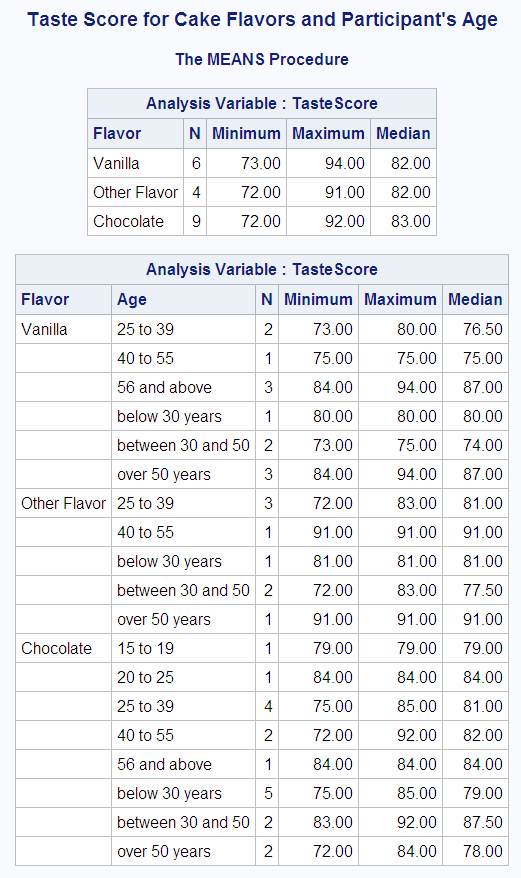MEANS Procedure
- Syntax

- Overview
- Concepts
- Using
- Results
- Examples
 Computing Specific Descriptive StatisticsComputing Descriptive Statistics with Class VariablesUsing the BY Statement with Class VariablesUsing a CLASSDATA= Data Set with Class VariablesUsing Multilabel Value Formats with Class VariablesUsing Preloaded Formats with Class VariablesComputing a Confidence Limit for the MeanComputing Output StatisticsComputing Different Output Statistics for Several VariablesComputing Output Statistics with Missing Class Variable ValuesIdentifying an Extreme Value with the Output StatisticsIdentifying the Top Three Extreme Values with the Output StatisticsUsing the STACKODSOUTPUT option to control data
Computing Specific Descriptive StatisticsComputing Descriptive Statistics with Class VariablesUsing the BY Statement with Class VariablesUsing a CLASSDATA= Data Set with Class VariablesUsing Multilabel Value Formats with Class VariablesUsing Preloaded Formats with Class VariablesComputing a Confidence Limit for the MeanComputing Output StatisticsComputing Different Output Statistics for Several VariablesComputing Output Statistics with Missing Class Variable ValuesIdentifying an Extreme Value with the Output StatisticsIdentifying the Top Three Extreme Values with the Output StatisticsUsing the STACKODSOUTPUT option to control data - References
Example 5: Using Multilabel Value Formats with Class Variables
| Features: |
TYPES statement |
| Other features: |
FORMAT procedure FORMAT statement |
| Data set: | CAKE |
Program
options nodate pageno=1 linesize=80 pagesize=64;
proc format;
value $flvrfmt
'Chocolate'='Chocolate'
'Vanilla'='Vanilla'
'Rum','Spice'='Other Flavor';
value agefmt (multilabel)
15 - 29='below 30 years'
30 - 50='between 30 and 50'
51 - high='over 50 years'
15 - 19='15 to 19'
20 - 25='20 to 25'
25 - 39='25 to 39'
40 - 55='40 to 55'
56 - high='56 and above';
run;
proc means data=cake fw=6 n min max median nonobs;
class flavor/order=data; class age /mlf order=fmt;
types flavor flavor*age;
var TasteScore;
format age agefmt. flavor $flvrfmt.;
title 'Taste Score for Cake Flavors and Participant''s Age'; run;
Program Description
Set the SAS system options. The
NODATE option suppresses the display of the date and time in the output.
PAGENO= specifies the starting page number. LINESIZE= specifies the
output line length, and PAGESIZE= specifies the number of lines on
an output page.
Create the $FLVRFMT. and AGEFMT. formats. PROC FORMAT creates user-defined formats to categorize
the cake flavors and ages of the participants. MULTILABEL creates
a multilabel format for Age. A multilabel format is one in which multiple
labels can be assigned to the same value, in this case because of
overlapping ranges. Each value is represented in the output for each
range in which it occurs.
proc format;
value $flvrfmt
'Chocolate'='Chocolate'
'Vanilla'='Vanilla'
'Rum','Spice'='Other Flavor';
value agefmt (multilabel)
15 - 29='below 30 years'
30 - 50='between 30 and 50'
51 - high='over 50 years'
15 - 19='15 to 19'
20 - 25='20 to 25'
25 - 39='25 to 39'
40 - 55='40 to 55'
56 - high='56 and above';
run; Specify the analyses and the analysis options. FW= uses a field width of six to display the statistics.
The statistic keywords specify the statistics and their order in the
output. NONOBS suppresses the N Obs column.
Specify subgroups for the analysis. The CLASS statements separate the analysis by values
of Flavor and Age. ORDER=DATA orders values according to their order
in the input data set. ORDER=FMT orders the levels of Age by ascending
formatted values. MLF specifies that multilabel value formats be used
for Age.
Specify which subgroups to analyze. The TYPES statement requests the analysis for the
one-way combination of Flavor and the two-way combination of Flavor
and Age.
Specify the analysis variable. The
VAR statement specifies that PROC MEANS calculate statistics on the
TasteScore variable.
Output
The one-way combination
of class variables appears before the two-way combination. A field
width of six truncates the statistics to four decimal places. For
the two-way combination of Age and Flavor, the total number of observations
is greater than the one-way combination of Flavor. This situation
arises because of the multilabel format for age, which maps one internal
value to more than one formatted value. The order of the levels of
Flavor is based on the frequency count for each level. The order of
the levels of Age is based on the order of the user-defined formats.
